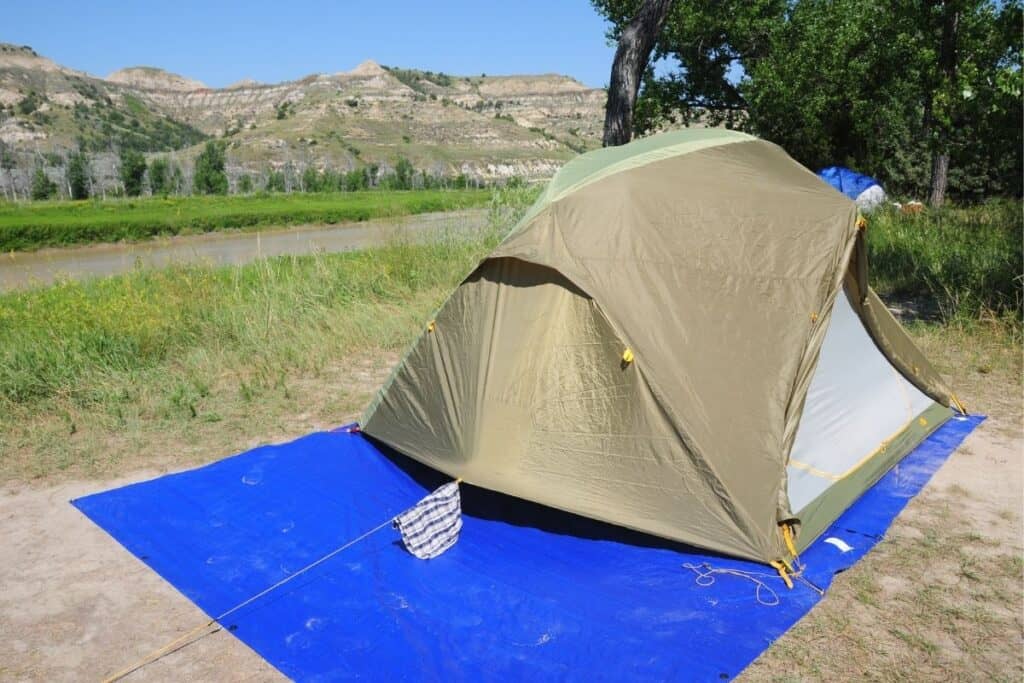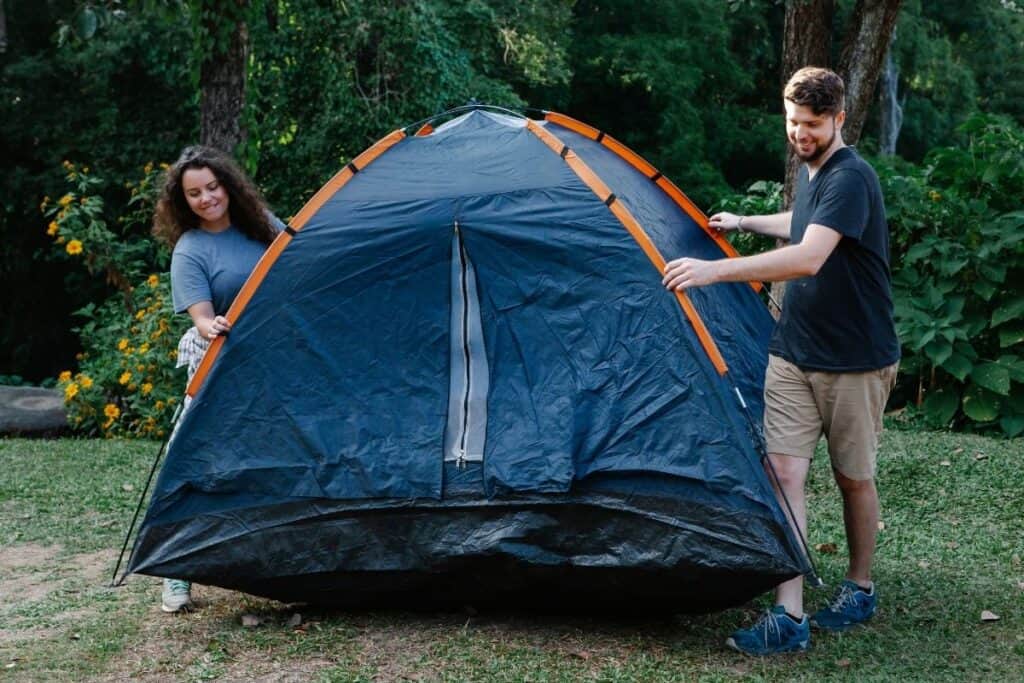
Have you just bought new tent only to find out that it’s recommended that you also purchase its corresponding tent footprint? If the tent floor is supposedly water-resistant and durable, what’s the point of having the footprint as well?
A tent footprint is a layer of fabric designed to lie between your tent and the ground to provide an extra layer of moisture protection and prevent any unnecessary scratches or abrasions to the bottom of the tent.
Even if you buy an incredibly nice tent known for being waterproof and durable, it’s still wise to use a tent footprint. There are several factors besides the tent itself that need to be taken into account when deciding if you need the tent footprint or not.
A tent footprint will save you time and effort and prevent you from having to buy another tent after only a couple of camping trips. You don’t even need to spend big money on a footprint, as there are plenty of cheap alternative options to choose from.
What Exactly Is A Tent Footprint?
Simply put – a tent footprint is just a layer of material that sits between your tent and the ground. It performs the same protective function as a case on your cellphone!
You may also hear to them referred to as a “groundsheet” or “ground cloth” as well.
Any type of dirtiness, abrasions, or water will affect the cheap tent footprint instead of your expensive tent. This vastly improves the longevity of your tent and makes setting up or taking down camp far easier.
Many tent manufacturers offer model-specific footprints that sized to exactly match the “footprint” of a given tent. However, many campers also take DIY approaches by using simple tarps for the same function.
Is a Tent Footprint Worth It?
Now that you’ve got a good understanding of what a tent footprint is, the next logical questions is wondering whether they’re worth the added expense.
The short answer is that there’s no reason to not use a tent footprint, even if you only plan on doing backyard camping.
The advantages stack up quickly, and it only adds an extra minute at most to setting up and taking down camp! Let’s take a look at some of these advantages in more detail.
Tent Longevity
Even the toughest of tents can wear out faster than we expect. Aside from comfort, this is why it’s wise to clear the area where you’ll be pitching your tent of any rocks and sticks as they can damage the tent bottom.
However, it’s easy to miss a few items and over time these small items will slowly wear wear holes into the bottom of your tent floor.
Once you set up your gear inside the tent, it puts a lot of pressure against any potential hazards like the twigs and stoney ground. Tent bottoms aren’t fragile enough that one night will do anything, but multiple nights of rough treatment can cause damage.
Let’s face it – tents are not cheap!
It’s far cheaper to replace a tent footprint instead of your entire tent. Most footprints are under $50, with the majority coming in at far less than that.
Insulation
People tend to assume that once you zip up the tent your body heat will fill the tent and keep you warm throughout the night. However, the ground is notorious for leaching away heat due to conduction, and even with a sleeping bag, you’ll have a cold night ahead of you.
Tent footprints help trap heat inside the tent in two ways:
- The first is providing a divide between you and the ground, preventing the biggest source of heat loss from taking effect.
- The second is an extra layer to keep heat from seeping out of your tent during the night.
The ground tends to be uncomfortable, and a tent footprint gives an extra layer of cushion you wouldn’t normally have.
People who truly want comfort will go glamping rather than camping, but any extra comfort layer is worth fighting for!
Waterproofing
Even the most high-end tents don’t have the best water-resistant floors. The liquid won’t come flooding in, but a night sitting on top of damp ground can let the moisture seep up into the tent and begin damaging your belongings or cause mold and mildew.
The extra layer of a tent footprint helps prevent the effects of a rainy night from seeping up into your tent. You’ll stay dry as well as all of your stuff.
It’s also far easier to clean and wipe off the groundsheet in the morning instead of your entire tent bottom.
Easier Pitching
Tent footprints shouldn’t extend much further than the size of your tent. Otherwise, it will allow water and muck to pool around the bottom of your tent.
Laying down a sheet or tarp the size of your tent before pitching helps to save a ton of time during the setup process.
A good space to set up camp may look perfect but can end up being too small or uneven once you get your tent situated. A tent footprint lets you easily map out how much room you need, and you can even lay down on it to check if the ground is even beforehand.
Picture the groundsheet as an easy to move blueprint for how much space you need. It reduces the hassle of setting up tremendously, and you’ll be able to find the perfect spot much more quickly.
Tent Specific
Not all tent footprints need to be fancy, but many are offered to match with specific tents. This saves you the time of measuring your tent’s bottom and trying to search accordingly. Just look up your specific tent, and there are often matching footprints that go with them.
These options are more expensive than DIY tent footprints, but sometimes the convenience of a perfect fit is worth the extra cash spent.
You’ll save time and won’t have to worry about forgetting to fold in loose fabric if your groundsheet is too large.
Weight
The big advantage of many tent footprints is how lightweight they are!
Hiking already involves carrying a large amount of heavy gear, and extra weight is usually unwelcome. An ideal tent footprint should weigh well under one pound.
Many official tent footprint options or tent specific versions available for purchase have heavy clasps or buckles to secure it to your tent.
So long as you or your gear is inside the tent, there’s no real chance of your tent or the groundsheet getting blown away, making the extra weight worthless.
Campsite
It may sound strange, but using a tent footprint is more important if you plan on camping at a popular campground. Areas where many people have slept or set up camp can create divots in the ground where water and mud can collect.
In the wilderness, using a tent footprint depends on the material you’re camping on. The abrasive or sandy ground should absolutely have a tent footprint, whereas a well-drained mossy forest floor is probably good enough where you don’t need one.

Do You Need A Tent Footprint?
A tent footprint is entirely optional. It all depends on how much you want to protect your tent. If you don’t care about your tent or are only going camping once, you don’t necessarily need a groundsheet.
It’s definitely far better to use one if you are an avid camper. A useful DIY tent footprint can cost as little as $2, so using one isn’t an inconvenience at all. Consider the groundsheet as an essential camping tool and you won’t regret it.
Now that you know why you should use a tent footprint and the advantages, here’s some more information to help you pick the best option to fit your needs.
What Size Do I Need For My Tent?
The optimal size for a tent footprint is just a bit smaller than the base of your tent. This allows the advantages of insulation and protection while avoiding excessive water contact.
Measuring out your camping spot with the groundsheet also helps make a more educated decision rather than guessing.
A footprint that is too large helps to collect moisture and rain underneath your tent, which can cause mildew and mold much faster than expected. If your groundsheet is too big, either fold/tuck it so that there’s no overlay or don’t bother using it during bad weather.
DIY Tent Footprint Materials
Most people tend to go with DIY options because of how easy and cheap they are to use. These options barely cost a thing, but they definitely get the job done.
Painters Tarp Sheet
This option is 2mm thick and weighs next to nothing. It only costs around $2 and is incredibly easy to both set up and carry around.
It’s water resistant and easy to clean off if you end up camping in a muddy spot.
Plastic Tablecloth
Water resistant, cheap, and easy to carry around makes a tablecloth a great choice.
The only downside is it’s not sized for a tent so you may have to make some adjustments or do some folding at the camp.
Tyvek
Tyvek is a great option to choose from for a DIY tent footprint. Their material is flash spun high-density polyethylene fibers, which is perfect for your camping needs.
This lightweight and durable material should last you through thick and thin.
Conclusion
A tent footprint is an essential piece of camping gear meant to keep your tent long-lasting and in good condition. It improves water resistance, abrasions, and makes the entire setup and takedown process much faster and easier.
DIY options are often equally suitable to “official” manufacturer footprints. As long as it’s a bit smaller than your tent base and made of a water-resistant material, you’ll be good to go.
Just make sure to check that it’s lightweight and scope out your campsite beforehand!
Related Articles
If you found this article helpful, then make sure to also take a look at my other related articles!
